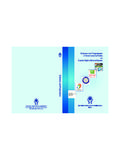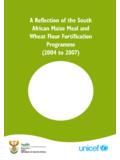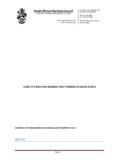Transcription of Chapter 4: Determinants (Risk and protective factors ...
1 FINAL DRAFT - March 2004 FINAL DRAFT - March 2004 1 Chapter 4: Determinants (Risk and protective factors ) Indicators Overview Adolescent behaviours are influenced by a variety of factors which, in turn, are dependent on differences in relationships, settings, cultures, and economic conditions. These factors are called Determinants as they determine, or influence, individual behaviours. Determinants can be either positive or negative, and, depending on their effect, they are often referred to as risk or protective factors . Definition of Risk and protective factors : Risk factors are conditions or variables associated with a lower likelihood of positive outcomes and a higher likelihood of negative or socially undesirable outcomes.
2 protective factors have the reverse effect: they enhance the likelihood of positive outcomes and lessen the likelihood of negative consequences from exposure to risk. Jessor, Turbin and Costa Risk and protection in successful outcomes among disadvantaged adolescents 1998 In the context of HIV/AIDS prevention, risk factors increase the chances that adolescents will engage in sexual-risk taking or otherwise expose themselves to HIV. protective factors decrease that chance. An example of a risk factor for early sexual debut is having the perception that one s friends are sexually active. Youth who perceive that their friends are sexually active are more likely to have had sex themselves.
3 Examples of protective factors include "positive attitudes toward contraception," and "ability to refuse unsafe sex." Some Determinants , such as age, sex, beliefs and attitudes, relate to the individual, while others relate to peer, family, and community influences, and the broader socio-economic environment. The importance of factors external to young people is intrinsic to the WHO/UNFPA/UNICEF Framework for Programming for Adolescent Health and Development ("Action for adolescent health: towards a common agenda, ), which emphasises that the creation of a safe and supportive environment is fundamental to adolescent health and development. It is these indicators that provide information about the Determinants that underlie behaviours and HIV transmission in young people, and provide the basis for immediate and long-term responses to the prevention of HIV/AIDS among young people.
4 Programme managers and evaluators responsible for developing and monitoring programmes for young people need to monitor and assess these Determinants if their efforts are to be effective and have an impact on the problems that undermine young people s health and development. Why is Collecting Data on Determinants (Risk and protective factors ) Important for Managers? The routine collection of data about the context of young people s lives is important for programme managers for a number of reasons: advocacy, so that a compelling case can be made for investing in interventions that decrease young people s vulnerability, and subsequently the likelihood of them adopting behaviours that decrease the transmission of HIV FINAL DRAFT - March 2004 FINAL DRAFT - March 2004 2 targeting interventions such as information, life skills and health services, in order to ensure that those young people who are most vulnerable are not excluded from the provision of key interventions developing and implementing interventions that are not only directed to individual young people themselves, such as information, skills and services.
5 But that are also directed to the environments in which they live, learn and earn policies, so that these can include a focus on those factors that increase young people s vulnerability and ensure that their rights are protected, and to provide a way to regularly assess the implementation of those policies that have been developed The key indicators that need to be considered by programme managers are outlined in this Guide under three groups: socio-demographic characteristics, vulnerable sub-populations, and the key Determinants of HIV-relevant behaviours . Socio-demographic characteristics describe the target population, such as the distribution of age, marital status, religious affiliations, living arrangements, and urban/rural residence.
6 Much of these data are widely collected through census reporting and through established surveys, such as the Demographic and Health Surveys (DHS) and Multiple Indicator Cluster Surveys (MICS). Details regarding the collection of these indicators are not provided, because new data collection is not required. What is frequently required, however, is disaggregation of existing data by age, sex and marital status so that information specific to young men and women is available. Indicators in this category include: 1. Proportion of the national population aged 10-14, 15-19 and 20-24 2. Proportion of the urban population aged 10-14, 15-19 and 20-24 3. Proportion of the rural population aged 10-14, 15-19 and 20-24 4.
7 Proportion of young men and women in school aged 10-14, 15-19 and 20-24 5. Proportion of young men and women who are currently married aged 10-14, 15-19 and 20-24 6. Median age at first marriage for young men and women 7. Median age at first birth 8. Proportion of young people living on income below the poverty line (nationally defined), aged 10-14, 15-19 and 20-24 9. Distribution of population (adult, and young people) by religious denominations, aged 10-14, 15-19 and 20-24 10. Proportion of population (adult, and young people) expressing accepting attitudes towards people living with HIV 11. The proportion of young men and women who have access to mass media (radio, television, internet), aged 10-14, 15-19 and 20-24 FINAL DRAFT - March 2004 FINAL DRAFT - March 2004 312.
8 Proportion of young men and women working outside the home, aged 10-14, 15-19 and 20-24 13. Proportion of young men and women who live with their parents, aged 10-14, 15-19 and 20-24 The second group of indicators are related to specific vulnerable sub-populations of youth, such as injecting drug users, young people orphaned by HIV/AIDS, and commercial sex workers. Details regarding the collection of data for these indicators are also not being provided in this guide, as other guides provide detailed information on sampling each of these groups (specifically: Behavioural Surveillance Surveys: Guidelines for repeated behavioural surveys in population at risk of HIV, published by Family Health International; and the forthcoming Guide to monitoring and evaluation of the national response for children orphaned and made vulnerable by HIV/AIDS, UNAIDS and UNICEF).
9 Indicators in this category include: 1. Number and proportion of injecting drug users who are between the ages of 10-14, 15-19, and 20-24. 2. Number and proportion of commercial sex workers who are between the ages of 10-14, 15-19, and 20-24. 3. Number and proportion of young men who have sex with men (age 10-14, 15-19, 20-24). 4. Proportion of young people (10-14, 15-18) who are orphaned. The last group of indicators describe the key Determinants (risk and protective factors ) of behaviours particularly relevant for HIV prevention. Many of them are still in the development stage, but have been included in this Guide to provide programme managers with an indication of the aspects of young people s lives that need to be monitored.
10 It is anticipated that the experiences gained in measuring these indicators will make important contributions to future versions of this Guide. Below is a list of these indicators, with more details on each in the pages that follow: Determinants (Risk and protective factors ) 1. Knowledge of HIV prevention among young people o Nationally representative general population survey C C 2. Knowledge of a formal source of condoms among young people o Nationally representative general population survey C C 3. Sexual decision-making among young people o Nationally representative general population survey A A 4.
















